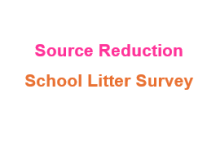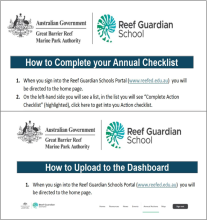- All pages
- Primary school
- Middle school
- Senior school
STEM Activity - Ozobot Colour Codes Chart
Use this colour code chart to help program your ozobot.
Seahorse with Babies Craft
This fun craft activity will have baby seahorses popping out of their dad's pouches all over the classroom.
Reef Babies
Are reef animals born live or do they hatch from eggs? Do they look like their parents? Do their parents look after them? Students can use this worksheet to record the similarities and differences of six reef animals presented during the "Growing up on the Reef" Virtual Learning Experience.
Lucky Turtle Puppet Show Colouring Sheet
Find all your favourite characters from the Lucky Turtle puppet show and colour them in!
Lucky Turtle Puppet Show Worksheet
After watching the Lucky Turtle Puppet Show students can test their listening skill to show what Lucky Turtle eats, and which animals warned Lucky about specific threats.
2025 RGS Eco Challenge Participant Guide.pdf
This guide contains information about the 2025 Reef Guardian Schools Eco Challenge including participation and entry guidelines and details of each of the eight challenges.
Pagination
STEM Activity - Ozobot Colour Codes Chart
Use this colour code chart to help program your ozobot.
Seahorse with Babies Craft
This fun craft activity will have baby seahorses popping out of their dad's pouches all over the classroom.
Reef Babies
Are reef animals born live or do they hatch from eggs? Do they look like their parents? Do their parents look after them? Students can use this worksheet to record the similarities and differences of six reef animals presented during the "Growing up on the Reef" Virtual Learning Experience.
Lucky Turtle Puppet Show Colouring Sheet
Find all your favourite characters from the Lucky Turtle puppet show and colour them in!
Lucky Turtle Puppet Show Worksheet
After watching the Lucky Turtle Puppet Show students can test their listening skill to show what Lucky Turtle eats, and which animals warned Lucky about specific threats.
2025 RGS Eco Challenge Participant Guide.pdf
This guide contains information about the 2025 Reef Guardian Schools Eco Challenge including participation and entry guidelines and details of each of the eight challenges.
Pagination
STEM Activity - Ozobot Colour Codes Chart
Use this colour code chart to help program your ozobot.
2025 RGS Eco Challenge Participant Guide.pdf
This guide contains information about the 2025 Reef Guardian Schools Eco Challenge including participation and entry guidelines and details of each of the eight challenges.
Be a Marine Biologist for a Day Survey Slate
The survey slate used when conducting a 10-minute timed-swim survey as part of the Rapid Monitoring: Be a Marine Biologist for a Day program.
Captain Popper Stopper
Captain Popper Stopper is a fun skit talking about the pros and cons of poppers and reusable bottles.
Source Reduction - School Litter Survey
Conduct a litter survey by collecting and recording any litter you find around your school grounds. You could conduct a number of these or just one in a lunch break. Once you have collected your data, analyse it on the following page. Any items that not listed below you can create an additional item in the blank sections.
Source Reduction Plan Instructions
Everyone can help reduce marine debris, even if you live far away from the coast. Land and ocean are connected through waterways, and every action from changing consumption habits to cleaning up the environment to big scale projects can make a difference to one of the largest environmental issues.
Aims/Outcomes:
• Students develop an understanding of how litter ends up as marine debris
• To challenge students to identify ways to reduce litter at its source in their schools
• To promote student involvement in on the ground projects and actions in their schools
Pagination
2025 RGS Eco Challenge Participant Guide.pdf
This guide contains information about the 2025 Reef Guardian Schools Eco Challenge including participation and entry guidelines and details of each of the eight challenges.
Be a Marine Biologist for a Day Survey Slate
The survey slate used when conducting a 10-minute timed-swim survey as part of the Rapid Monitoring: Be a Marine Biologist for a Day program.
Captain Popper Stopper
Captain Popper Stopper is a fun skit talking about the pros and cons of poppers and reusable bottles.
Source Reduction - School Litter Survey
Conduct a litter survey by collecting and recording any litter you find around your school grounds. You could conduct a number of these or just one in a lunch break. Once you have collected your data, analyse it on the following page. Any items that not listed below you can create an additional item in the blank sections.
Source Reduction Plan Instructions
Everyone can help reduce marine debris, even if you live far away from the coast. Land and ocean are connected through waterways, and every action from changing consumption habits to cleaning up the environment to big scale projects can make a difference to one of the largest environmental issues.
Aims/Outcomes:
• Students develop an understanding of how litter ends up as marine debris
• To challenge students to identify ways to reduce litter at its source in their schools
• To promote student involvement in on the ground projects and actions in their schools
How to Guide for Teachers: Adding Annual Actions and Posting to the Dashboard
This guide provides step-by-step instructions for teachers on how to effectively add their annual actions to the Reef Guardian Portal and post updates to the dashboard. Whether you’re sharing exciting initiatives, classroom projects, or community engagement activities, this guide will help you showcase your achievements and inspire others.













